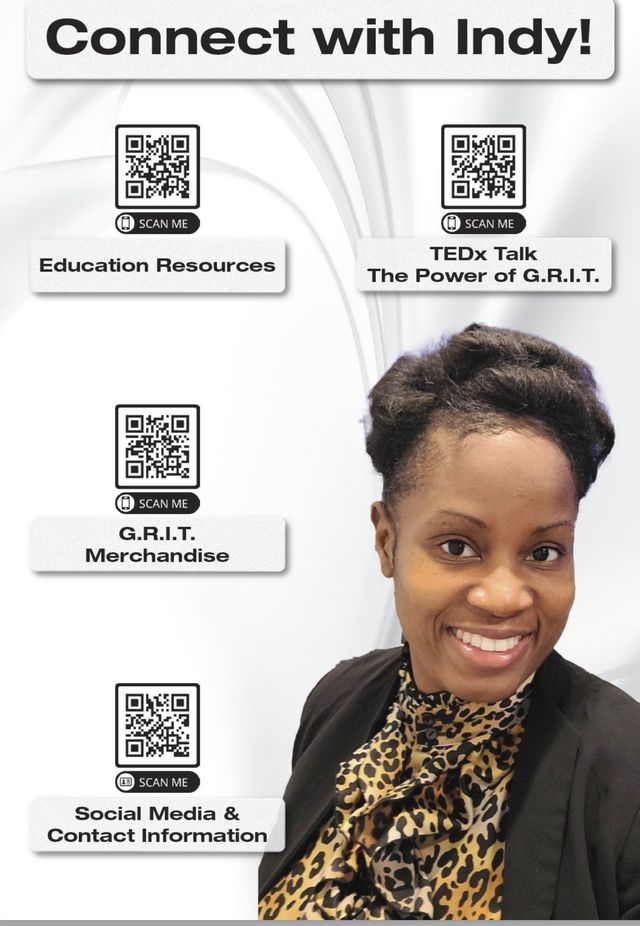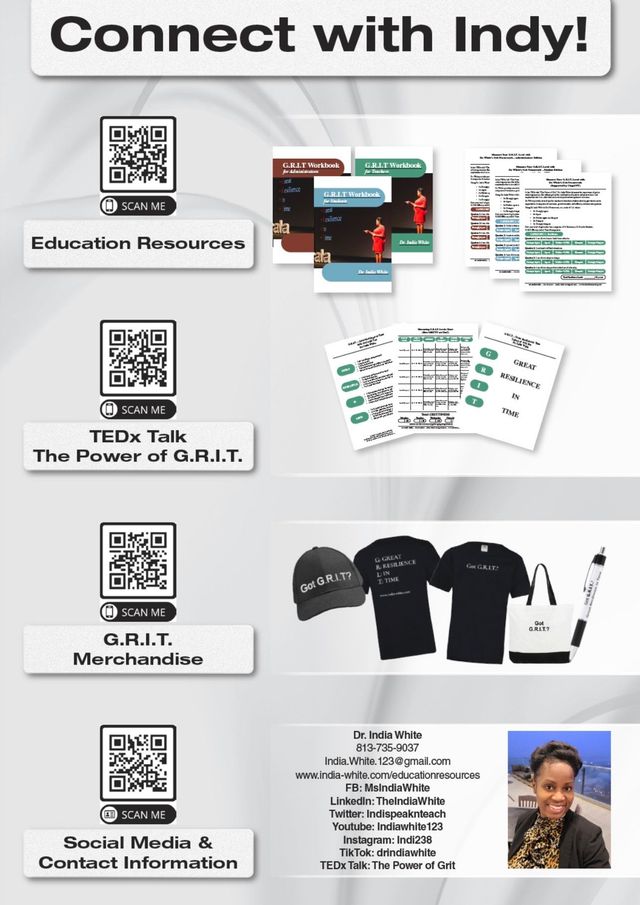Turbulence is Bound to Happen; Are You Still Willing to Fly?
India White • August 3, 2023
Turbulence Will Happen; Will You Still Fly?
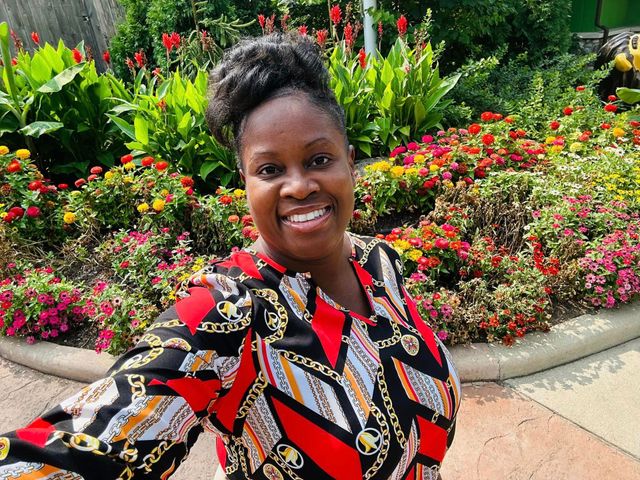
Turbulence is Bound to Happen; Are You Still Willing to Fly?
I recently experienced turbulence on a flight to an event, when the pilot made an announcement that it was expected due to a light storm. We were flying through a cloud, and it began. I’ve always thought turbulence was very annoying and I always turn into a top-notch prayer warrior as I dispatch angels to keep the plane and bind the will of the enemy. However, the turbulence eventually cleared, and all was well again.
Turbulence is a part of life. We must expect that life will come in cycles,
and hence, we cannot allow bad times to cause us to give up on our destiny. In life, you will have moments of turbulence including the loss of a loved one, a job cut, dealing with friends and families dealing with trauma, drug addiction and more. Although these episodes can be discouraging, things are bound to get better. However, during the moments of turbulence, it seems like there’s no end.
I want to encourage you to keep your head up and remember to look up into the hills from whence comes your help (Psalm 121: 1). Further, remember that your times are in His hands (Psalm 31:15). If God created the heavens and earth (Genesis 1:1), and has sustained it for several thousand if not millions of years, what is our little span of life to Him? Can he not keep our lives? Can he not take charge and speak peace to our storms and dismantle all turbulence, even in a moment
(Mark 4:39)? Sometimes, we must reactivate God’s position on the throne in our lives, and remember that his ways are not our ways, and that whatsoever he desires that will he do. We must allow God to prove that he is GOD and that his strong arm is AWESOME. Believe me, he doesn’t need our help.
Therefore, although life can throw curve balls, and can cause you to fear taking risks and flying high in success and in God’s will, I want to encourage you to fly anyway. The last thing we want to do is to sit back in fear of failure, or fear of criticism, and ultimately missing out on the plan that God had for our lives. Choose to shake off all doubt, inferiority complex, low self-esteem and soar beyond your dreams!
Give life a chance again! Instead of throwing in the towel, shake your towel out, and go at it again! You have so much purpose deeply rooted within you and people all around you are waiting for your to strike big and impact on levels you’ve never dreamt of. So, take life by the horns, and show your low moments how high you’re going to bounce back! Continue to cultivate a plan for a comeback, and don’t stop until you are thriving in success! Put your life in GOD’s hands and watch him work things out for you! Remember, he said he will bring you into an expected end; so give him the chance to do it!
Here are some tips to help you fly high beyond the turbulence of life:
1: Remember that no weapon formed against you shall prosper!
Isaiah 54:17 mentions that “no weapon formed against us shall prosper” and that every tongue that rises against us in judgement we can condemn. God has orchestrated your life as one that is set up for success. Hence, anyone or anything plotting to harm you it shall BOOMERANG back on their heads! Know that God keeps fabulous notes, and he sees and hears all things. He’s got you covered!
2: If you are at your lowest, you can only rise higher!
Life is meant to have moments of a bounce like a basketball. However, when you endure the pain and hardships of your bounce, you must recycle the episodes, hurts and trauma to build something beautiful in your next chapter of life. Never feel like life is “over” or it’s “too late”. Those are lies from the enemy, and you must learn to cast those negative thoughts down, become grateful for the hardships, and trust that this will all work out for your good!
3: Trust God and give him an opportunity to show his power!
God Almighty tells his people to trust him (Proverbs 3:5). Isaiah 6:1 mentions how the Lord is seated upon a throne, high and lifted up, and his train fills the temple. Further, he split the Red Sea (Exodus 14) and his people walk across the red sea on dry ground for his glory. He has raised the dead, healed so many that we cannot count or track it all. He communicates with all people from all backgrounds and languages and has been highly established as Sovereign Lord. Hence, allow GOD to show his power
during your turbulence, and praise him in expectation that he’s going to fix it!
4: Look up and prepare to fly high!
Sometimes, turbulent moments in life can cause us to lose focus on the mission, causing us to sometimes let go of our calling and vision that we know we are to fulfill. Hence, take a moment to acknowledge the turbulence, but factor it in as a part of the destination. Turbulence doesn’t end the destination; it strengthens you as you make strides towards your destination.
Hence, give your pain to God, and write a vision and make it plain (Habakkuk 2:2-3) as to how you will choose to succeed in this life!
5: Release doubt, negative people, and negative affirmations
It can be tough to soar high with negative thoughts, people, and affirmations we speak over ourselves. Why? Because the battleground is in the mind before it manifests in other areas of our lives. Hence, take a moment to write down or recall any negative thoughts or people you have allowed to affect your mental psyche and come up with a plan as to how you can recalibrate your thoughts and your life.
Then, use discipline and diligence to move forward in all aspects of your life, trusting God every step of the way.
Conclusion
As you navigate through life, take God with you and trust that in the end you will win. Choose to conquer turbulence by remembering that no weapon formed against you shall prosper, expecting to rise from low moments, preparing to fly high and releasing all doubt, negative people, and negative affirmations. You’ve got this, so remember to take grit with you as you soar through turbulence while trusting the Lord. I wish you the best as you fly despite all turbulence, reaching higher heights than you could have imagined!
Need More? Join my life coaching sessions in my Coaching Rockstars Program Today!
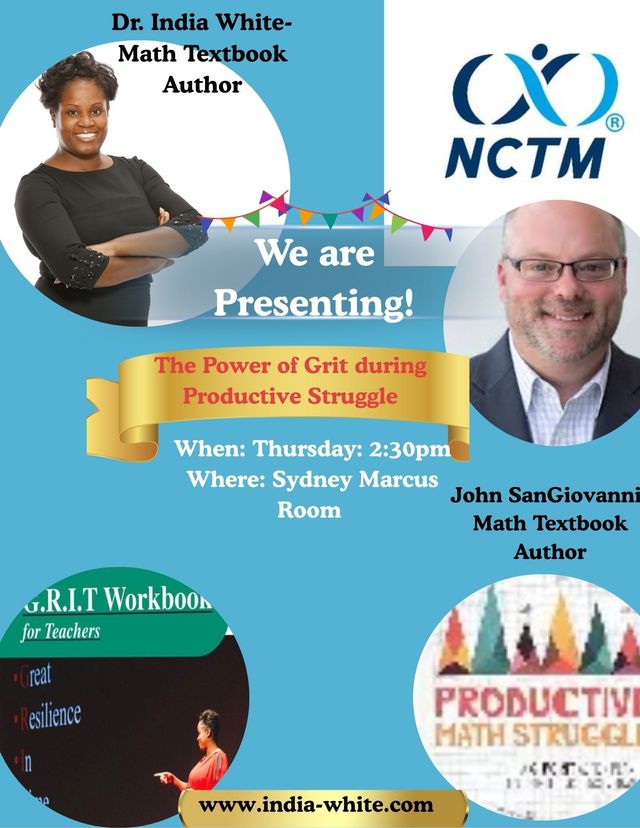
1 am excited to share that I will be a featured speaker at the NCTM 2025 Conference alongside the amazing John SanGiovanni. Together, we’ll explore the power of grit and productive struggle in the mathematics classroom—two essential ingredients for deep and lasting learning. John SanGiovanni will share his expertise on productive struggle, focusing on how teachers can design meaningful math experiences that challenge students to think critically, reason deeply, and persevere through complex problems. His work emphasizes that learning happens not when math is easy, but when students engage in struggle that leads to understanding and growth. In my portion of the session, I’ll discuss building grit through the G.R.I.T. Framework; Growth Mindset, Resilience, Self-Efficacy, and Time Management. Drawing from my G.R.I.T. Workbook for Educators, I’ll share practical tools and strategies educators can use to help students embrace challenges with confidence and persistence. By connecting grit to productive struggle, we can empower students to develop both the mindset and skills they need to overcome obstacles and achieve success in mathematics and beyond. I look forward to connecting with fellow educators at NCTM 2025 as we explore how to inspire perseverance, confidence, and a love for learning through grit and productive struggle.
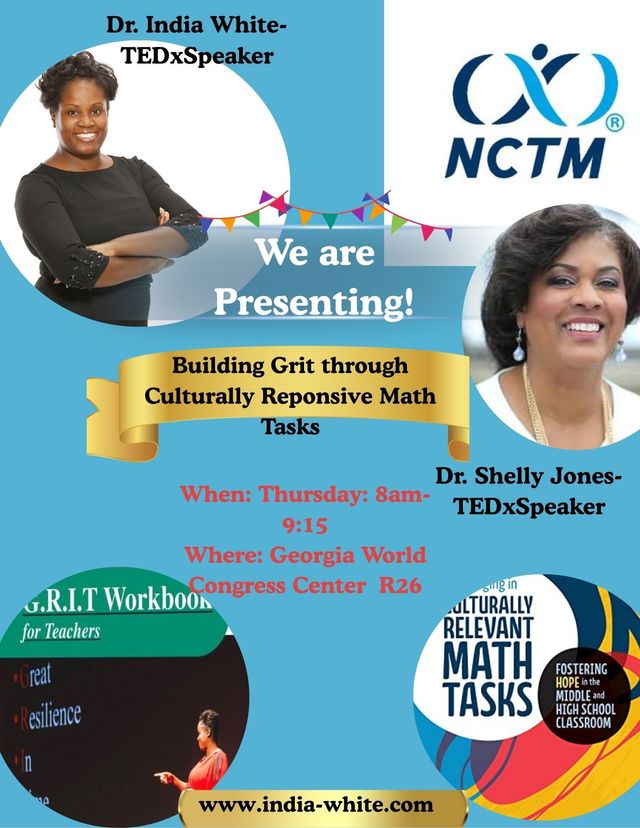
I am thrilled to announce that I will be a featured speaker at the NCTM 2025 Conference alongside the incredible Dr. Shelly Jones, Room 406. As TEDx speakers, Dr. Jones and I are uniting our passions for mathematics, equity, and purpose-driven teaching in our session titled Building Grit Through Culturally Relevant Math Tasks. Dr. Shelly Jones will share powerful insights from her book Culturally Relevant Math Tasks to Engage All Learners, which emphasizes how educators can connect mathematical concepts to students’ cultural experiences and lived realities. Her work highlights the importance of inclusion, representation, and authentic learning experiences that empower every student to see themselves as capable mathematicians. In my portion of the session, I will focus on Building Grit through the G.R.I.T. Framework—which stands for Growth Mindset, Resilience, Self-Efficacy, and Time Management. Through this framework, I will share strategies from my *G.R.I.T. Workbook for Educators* to help teachers cultivate perseverance and confidence in students as they navigate challenging math tasks. The goal is to help students not only solve problems but also believe they can thrive through productive struggle and perseverance. Together, Dr. Jones and I aim to inspire educators to blend cultural reasoning with resilience-building practices—creating classrooms where students’ identities and determination are celebrated equally. I’m excited to connect with passionate educators at NCTM 2025 and share how we can all build grit, equity, and excellence in math education.
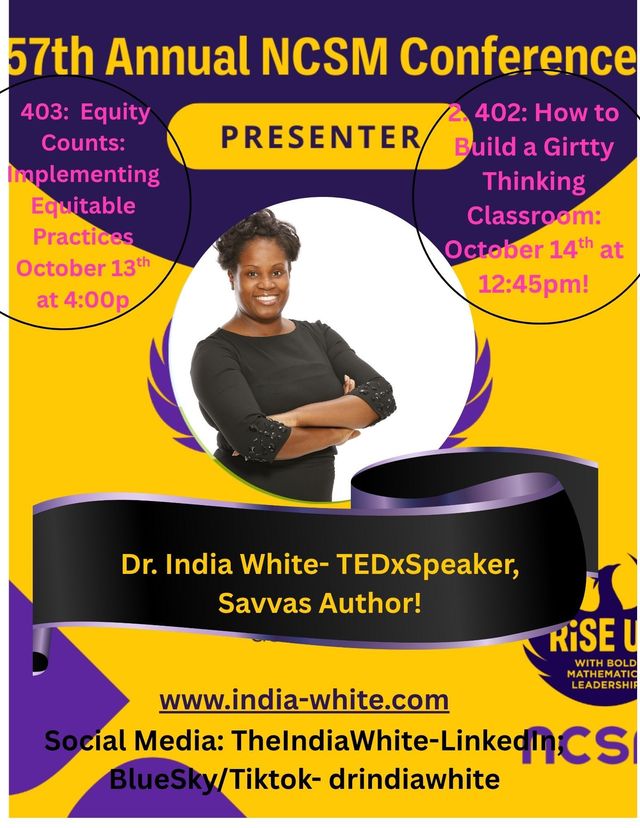
🌟 Exciting news! I’m thrilled to announce that I’ll be speaking at NCSM! 🎉 Join me for two informative sessions: 📚 402 How to Build a Gritty Thinking Classroom through Equity and Collaboration 🗓️ Tuesday, October 14, 2025 ⏰ 12:45 p.m. - 1:45 p.m. 📖 403 Equity Counts: Implementing Equitable Practices Across All Leadership Levels 🗓️ Monday, October 13, 2025 ⏰ 4:00 p.m. - 5:00 p.m. I’m ready to bridge the gap and give away door prizes, including my new book: Effective Teaching Practices Every Teacher Must Know! Don’t miss out! #nctm #ncsm #drindiawhite #grit #equity #parity NCSM: Leadership in Mathematics EducationNCTM - National Council of Teachers of MathematicsShelly M. JonesYolande Beckles
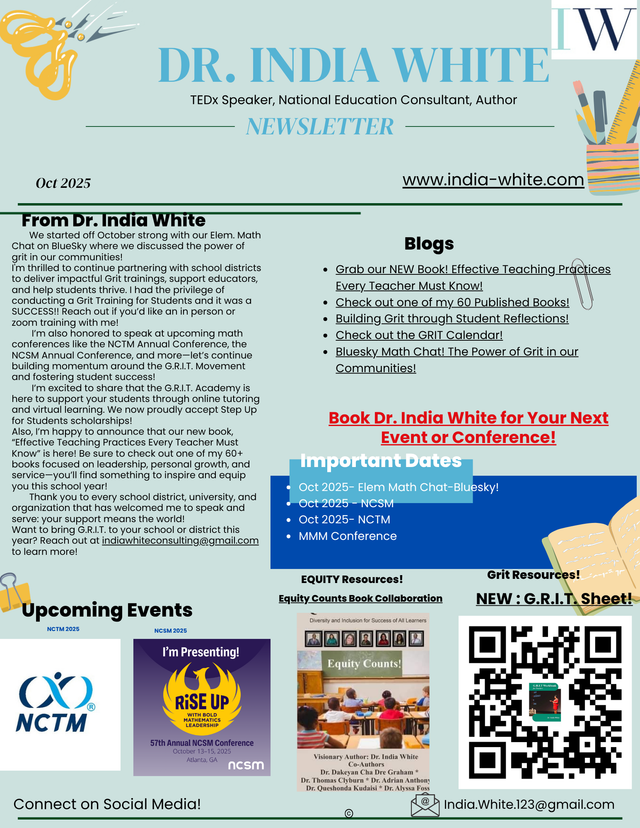
✨ Exciting October Update! ✨ I’m thrilled to share that my October Newsletter is live! This month, I’m honored to be speaking at both NCTM and NCSM—two powerful opportunities to connect with educators nationwide about building G.R.I.T. (Growth Mindset, Resilience, Self-Efficacy, and Time Management) and closing the achievement gap. 💡 I’m so grateful for the incredible teachers and leaders who continue to inspire and partner with me. Thank you for the work you do every day to make an impact in the lives of students! Check out the newsletter and explore resources here: 👉 www.india-white.com Let’s keep building grit and creating equity in education—together. 💪📚✏️
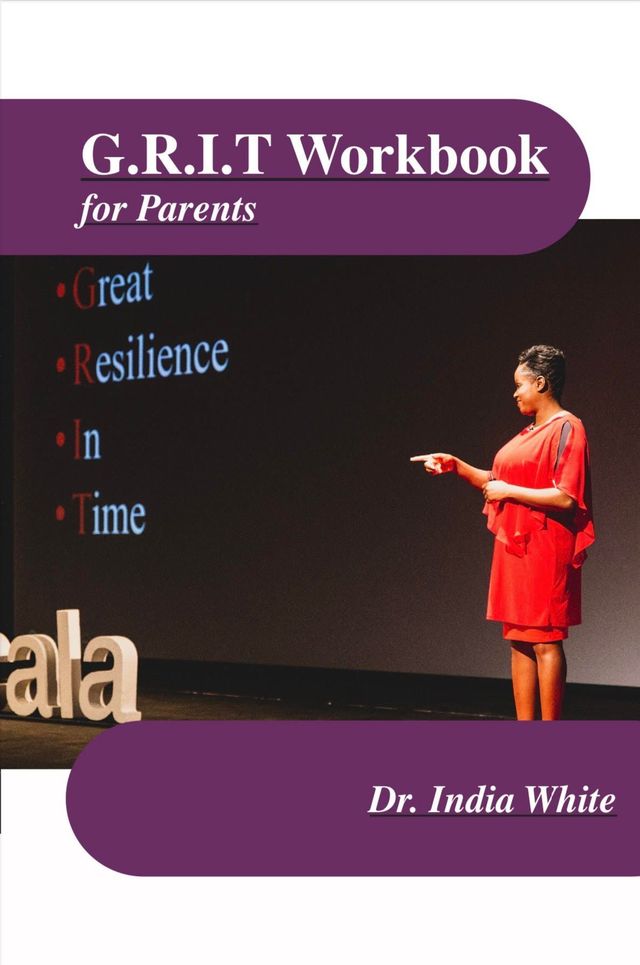
Building Grit in Our Elementary Math Communities This week I had the privilege of hosting an **Elementary Math Chat on BlueSky**, where educators from across the nation gathered to talk about one of my favorite topics: the **power of grit** in our classrooms and communities. The energy, collaboration, and passion from teachers, leaders, and math coaches reminded me once again of why this work matters. Why Grit in Math? We started by examining the latest NAEP data, which paints a sobering picture of how our students are performing in mathematics. While test scores often highlight areas of struggle, they also invite us as educators to ask a deeper question: How can we better equip our students to persist through challenges? This is where the G.R.I.T. framework—Growth Mindset, Resilience, Self-Efficacy, and Time Management—becomes a game-changer. Exploring the G.R.I.T. Framework During the chat, educators reflected on how grit shows up in their classrooms: Growth Mindset helps students believe they can learn math, even when it feels difficult. Resilience gives students the courage to keep trying when a solution isn’t clear right away. Self-Efficacy instills confidence that “I can solve problems if I keep working at them.” Time Management reminds students that persistence requires discipline and prioritization. Together, these pillars equip students to face not only academic challenges but also life’s challenges with courage and determination. G.R.I.T. Games and Assessments We also discussed two practical tools for teachers to bring grit alive in the math classroom: G.R.I.T. Games : Engaging activities that give students the chance to practice perseverance in fun, low-stakes ways while still reviewing math concepts. G.R.I.T. Assessment: A reflective tool for students to evaluate their own growth in grit—identifying where they are strong and where they can build more perseverance. These resources empower both teachers and students to see grit not as an abstract concept, but as something real, measurable, and impactful. Grit Beyond the Classroom One of my favorite takeaways from the chat was hearing educators share how grit impacts not just math performance but also the wider school community. When students develop grit, they become more confident problem-solvers, more engaged learners, and more supportive peers. This mindset spreads beyond the classroom walls, creating resilient communities that thrive together. Moving Forward The Elementary Math Chat reminded us that teaching math isn’t just about numbers—it’s about nurturing resilient thinkers who can face challenges with determination. As we continue to share strategies, reflect on data, and support one another, I’m excited to see how grit will transform classrooms across the nation. Let’s keep the conversation going: together, we can ensure every student has the tools to persist, grow, and succeed. Dr. India White is a national speaker, math consultant, and author of the G.R.I.T. framework. For professional development, G.R.I.T. trainings, or speaking engagements, connect at www.india-white.com
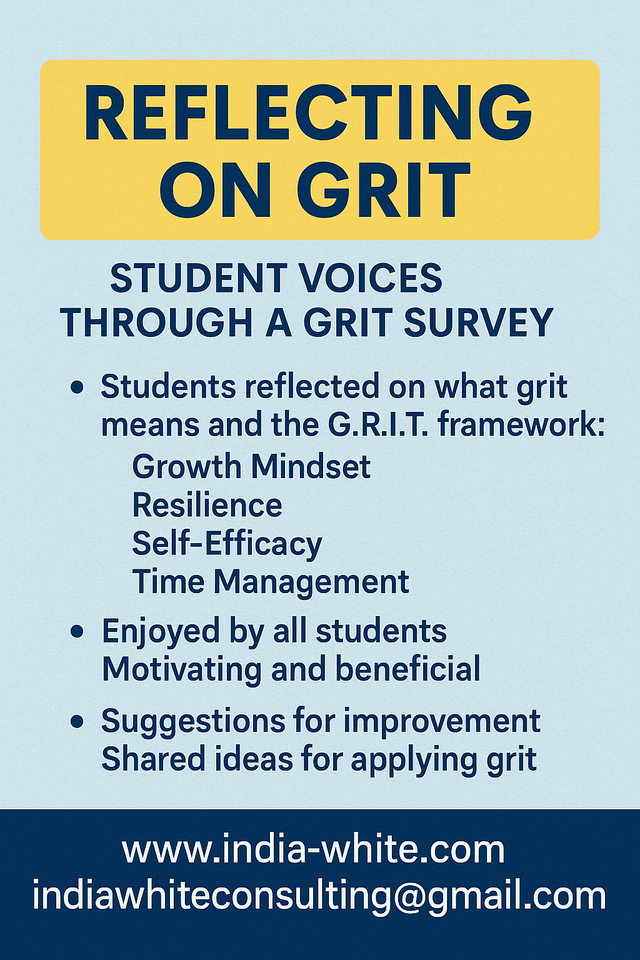
Building Grit in Students through Reflection Activities During a recent training session, I guided students through a structured activity designed to help them reflect on grit and personal accountability. This exercise encouraged them to explore how the G.R.I.T. framework—Growth Mindset, Resilience, Self-Efficacy, and Time Management—applies to their learning and development.^1 Students first participated in guided discussions on grit, focusing on strategies to remain committed, build resilience, and complete assignments on time.^2 Each student then journaled about their personal grit levels, identifying areas of strength and growth. This journaling provided a safe space for honest self-assessment and highlighted the importance of intentional focus.^3 The activity also included collaborative reflection where students discussed their “grit weeks,” emphasizing how to manage distractions, stay accountable, and complete tasks with perseverance.^4 By engaging in both personal reflection and peer discussion, students were able to see grit not as an abstract idea but as a practical tool to help them reach goals.^5 Through journaling and reflection, students deepened their understanding of the four pillars of the G.R.I.T. framework. Many expressed excitement for what lies ahead in their academic journey, recognizing that perseverance and accountability are vital to their long-term success.^6 The activity reinforced the importance of grit in education by providing students with practical tools for self-awareness and improvement. As Angela Duckworth emphasizes, grit involves sustained passion and perseverance over the long term.^7 Likewise, the Power of G.R.I.T. Workbook stresses that equipping students with reflective practices helps foster resilience and determination as they grow academically and personally.^8 Footnotes 1. Angela Duckworth, Grit: The Power of Passion and Perseverance (New York: Scribner, 2016), 8–9. 2. India White, The Power of G.R.I.T. Workbook (Tampa, FL: White Education Consulting, 2023), 12. 3. Duckworth, Grit, 44. 4. White, Power of G.R.I.T. Workbook, 28. 5. Duckworth, Grit, 92. 6. White, Power of G.R.I.T. Workbook, 46. 7. Duckworth, Grit, 275. 8. White, Power of G.R.I.T. Workbook, 59. Bibliography Duckworth, Angela. Grit: The Power of Passion and Perseverance. New York: Scribner, 2016. White, India. The Power of G.R.I.T. Workbook. Tampa, FL: Rising Glory Productions LLC, 2023.
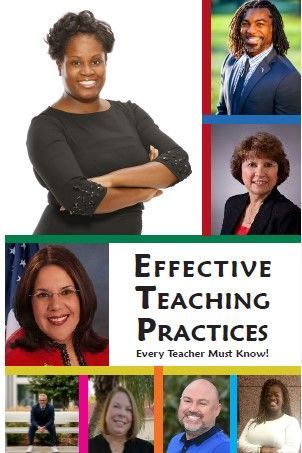
Grab Your Copy Today! The Effective Teaching Practices Every Teacher Must Know! Workbook is your guide to turning powerful teaching insights into action. Designed as a companion to the book, this workbook provides reflection prompts, guiding questions, and ample writing space to help you apply strategies from Dr. India White and her co-authors directly to your classroom. Whether you’re a new or experienced educator, this workbook will help you: - Adapt proven frameworks to meet the needs of your students. - Strengthen connections with families and communities. Reflect, plan, and grow as a teacher committed to excellence.Practical, reflective, and inspiring—this workbook will support your journey to becoming the most effective educator you can be. Visit www.india-white.com to grab your copy of the Effective Teaching Practices Every Teacher Must Know Book, as well as more resoruces for professioanld evleopment and more! Email indiawhiteconsulting@gmail.com for inquiries on future professional development or speaking opportunties with Dr. India White and authors. Workbook Link: Signed Copy Link: Book Also grab the EBOOK, now available on Amazon ! Or, Get your Paperback or Hardcover Copy for your Teachers today! Wait, don't forget to grab the BOOKs to go with the workbook! See below: Paperback Hardcopy Ebook

Listen to our LIVE Book Launch of Effective Teaching Practices Every Teacher Must Know!! We had an amazing time sharing tips and nuggets for teachers across the globe! Feel free to reach out to see how we can support you in your path! Grab Your Copy of the Book ( Paperback , Hardcover) or Workbook ( Hardcover , Paperback )today!
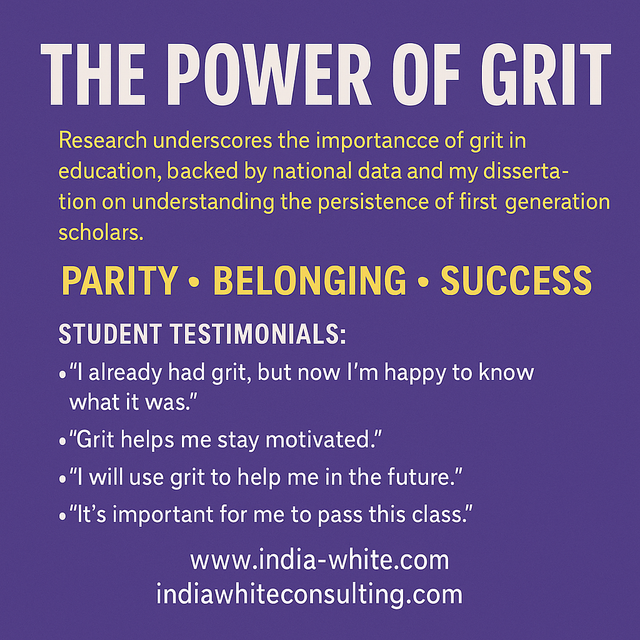
Cultivating Grit and Parity in the Classroom: Effective Strategies for Teachers In today’s educational landscape, fostering an environment where all students can thrive is more important than ever. Two concepts central to achieving this goal are grit and parity. Grit, characterized by perseverance and passion for long-term goals, and parity, which emphasizes equitable outcomes for all, work synergistically to create a foundation for student success. This blog explores practical strategies for implementing these ideas in the classroom, incorporating Dr. India White’s Grit Framework and essential pillars such as growth mindset, resilience, self-efficacy, and time management. Understanding Grit and Parity Grit is defined as the ability to maintain effort and interest over the long term despite challenges, as highlighted by Dr. Angela Duckworth. On the other hand, parity in education means ensuring that all students, regardless of their backgrounds or abilities, have equal opportunities to succeed academically. Creating a learning environment that emphasizes both concepts can support students in their academic and personal development. Teacher Tips for Effective Implementation of Grit and Parity 1. Set Clear, High Expectations: - Cultivate a classroom where high expectations are the norm. Communicating that effort is as important as achievement encourages students to embrace challenges and develop grit. - Strategy : Clearly outline objectives and performance standards, and highlight examples of resilience in achieving long-term goals. 2. Differentiate Instruction for Equitable Outcomes: - Offering tailored support to meet diverse student needs promotes parity. Use assessments to identify areas where students struggle, enabling you to provide targeted interventions and supports. - Strategy : Regularly assess student understanding and adjust instruction accordingly. Make use of various teaching modalities, such as small group instruction or one-on-one support. 3. Foster a Growth Mindset: - Instill the belief that abilities can be developed through dedication and hard work. A growth mindset, as defined by Dr. Carol Dweck, contributes to resilience and encourages students to see challenges as opportunities for improvement. - Strategy : Use positive language that reinforces effort and learning from setbacks. Encourage students to reflect on their learning journeys and recognize their growth over time. 4. Incorporate the Grit Framework: - Dr. India White’s Grit Framework outlines key pillars that support the development of grit: resilience, self-efficacy, and effective time management. By integrating these principles into your teaching, you can cultivate a classroom culture that encourages persistence. - Strategy : Embed discussions on resilience into lesson plans, and provide students with tools and strategies for improving self-efficacy and managing their time effectively. 5. Create Opportunities for Collaboration: - Collaborative learning environments enhance both parity and grit. When students work together, they learn from one another and build a supportive community that fosters resilience. - Strategy: Design team-based projects that encourage problem-solving and critical thinking. Assign roles that promote individual accountability while fostering group collaboration. 6. Celebrate Progress and Effort: - Shift the focus from solely recognizing final achievements to celebrating effort and incremental progress, reinforcing the value of grit. - Strategy : Establish a recognition system where students can share their efforts and successes, such as a “growth board” showcasing milestones related to resilience and persistence in learning. 7. Develop Time Management Skills: - Teaching students effective time management strategies helps them prioritize tasks and allocate time for practice and study, which is essential for developing grit and achieving parity. - Strategy : Provide tools such as planners or digital apps to help students organize their assignments and set realistic timelines. Teach them to set short- and long-term goals, breaking larger tasks into manageable steps. 8. Utilize Student Feedback: - Gathering student feedback about their learning experiences encourages them to express their needs and challenges. This insight guides the development of teaching strategies that promote both grit and p arity. - Strategy: Use surveys or class discussions to gather insights and adjust your teaching to better meet students' needs. Resources for Further Reading - Duckworth, A. (2016). Grit: The Power of Passion and Perseverance. Scribner. - This book delves into the significance of grit and provides strategies for fostering resilience and persistence. - White, I. (2020). Understanding the Persistence of First-Generation College Students (Doctoral dissertation). University of Florida. - This dissertation examines factors contributing to the persistence of first-generation students and offers practical recommendations for educators. - Dweck, C. S. (2006). Mindset: The New Psychology of Success. Random House. - This book discusses the implications of adopting a growth mindset in education and how it affects resilience and learning outcomes. Conclusion Integrating grit and parity into the classroom not only supports immediate academic success but also equips students with essential skills for lifelong learning. By implementing strategies that cultivate resilience, build self-efficacy, promote effective time management, and foster a growth mindset, educators can create an inclusive and supportive learning environment. In doing so, they empower every student to face challenges with tenacity and achieve their goals, transforming their educational journey into a path of success and fulfillment.

Empowering Students Through Parity, Grit and Belonging: A Guide for Educators In today’s educational landscape, the importance of creating environments that foster diversity, equity, inclusion (DEI), and fostering belonging is increasingly recognized. However, to truly drive student success, educators must evolve their focus towards parity and belonging—concepts that promote not just access, but also meaningful engagement and community within the classroom. Understanding Parity and Belonging Parity refers to ensuring that all students achieve equitable outcomes, regardless of their backgrounds. While DEI has focused on equal access to resources and opportunities, parity addresses the systemic barriers that prevent some students from realizing the same level of success as their peers. Belonging goes beyond inclusion; it emphasizes the need for students to feel accepted and valued within the learning community. When students feel they belong, they are more integrated into their classroom environment—promoting engagement and enhancing their overall educational experience. Dr. India White’s research on the Grit Framework offers a valuable perspective on this topic. Grit, defined as perseverance and passion for long-term goals, is essential for overcoming educational challenges. According to White (2020), cultivating grit empowers students to navigate adversities, making it a critical component in facilitating both parity and belonging in education. Furthermore, data from the National Assessment of Educational Progress (NAEP) highlights the disparities in academic performance across demographic groups, showcasing the need for targeted strategies that promote equal outcomes and a sense of belonging for all students (NAEP, 2021). Five Tips for Educators to Promote Parity and Belonging 1. Integrate Grit into the Curriculum: - Encourage students to set and pursue long-term goals. Share stories of resilience and perseverance, and engage them in discussions that emphasize the importance of grit in achieving success. Incorporate activities that challenge students to step out of their comfort zones while providing support as they navigate these challenges. 2. Utilize Data-Driven Instruction: - Leverage data from assessments like NAEP to identify gaps in student performance. Use this information to tailor instruction to meet the needs of all learners, ensuring that every student has access to the resources necessary for success. Regularly evaluate progress and adjust strategies to promote equitable outcomes. 3. Create a Supportive Classroom Culture: - Build a safe and inclusive classroom culture where all students feel valued. Encourage open dialogue about identity and differences, allowing students to share their experiences. Use team-building activities to foster a sense of community, promoting relationships that support everyone’s learning journey. 4. Collaborate with Families and Communities: - Involve families and community members in the educational process. Host workshops and events that engage parents and caregivers, providing resources that empower them to support their children’s education. Collaboration with community organizations can also enhance learning opportunities, extending support beyond the classroom. 5. Professional Development on Grit and Belonging: - Invest in ongoing professional development focusing on the principles of grit, parity, and belonging. Educators can learn strategies to foster resilience and ensure that they are equipped to create inclusive environments where all students can thrive. Learning together creates a unified approach, reinforcing a culture of belonging within the school. Conclusion As educators strive to create impactful learning experiences, the focus on parity and belonging emerges as essential to student achievement. By integrating Dr. India White’s Grit Framework into teaching practices, fostering supportive classroom cultures, and leveraging data to drive instruction, educators can ensure that all students have the opportunity to succeed. In doing so, they contribute to a future where every student not only has access to education but also a genuine sense of belonging. References NAEP. (2021). National Assessment of Educational Progress. Retrieved from [NAEP website]. White, I. (2020). Understanding the Persistence of First-Generation College Students (Doctoral dissertation). University of Florida.

